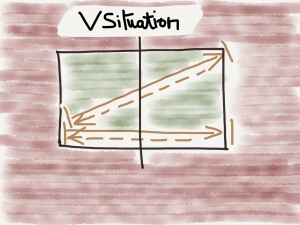Varying the placement of your strokes (direction, length) to prevent your opponent finding their distance
In order to vary the placement of their strokes, table tennis students use a number of different methods:
Limiting the limbs used (shoulder and wrist),
Associating or dissociating their legs and torso, arms and torso,
Managing how much energy is used (release).
Player 1
This student is at the right distance for his backhand and is keeping the angle of his racket adjusted to the moment of contact on the ball's trajectory. Here, he is varying the angle of the ball between diagonal and straight. Look at what he changes in order to accomplish this.
The photos show exactly what is happening at his legs, shoulders and arms.
As his legs are firmly on the ground, he adjusts his position by bending them more for some of the balls.
If he positions his legs and shoulders correctly, we can see that he mobilises his arm and his shoulder as a single unit.
He does not cross over much because he is playing with more of a “piston” movement than a rotation, and is not using his wrist.
Player 2
Here, the player mobilises her wrist upon impact, in order to give the ball speed and direction. Standing high up, she sometimes has difficulty adjusting if the ball is lower or faster.
Player 3
The arm is loose, but the torso-leg unit remains rigid. This prevents any adjustments in width or depth; the arm alone is performing these roles.
Player 4
This player, although shorter than the previous player, adjusts her position by bending her legs, giving herself a certain amount of stability and greater availability. This also enables her to play fully along the diagonal.
The torso and the arm move as a single unit; by loosening them up, she would have greater speed.
She changes direction both using her legs and her shoulders.
You can see a dissociation between the legs (which bend) and the torso (which turns).
Exercise 2:
Using a cross-court game, one of the two players can change direction. For this, keep track of the points scored.
Exercise 2, advanced:
The beginning of the point is a forehand diagonal; both players can change direction when they want. Service is alternated.
Advice from the coach:
Coaches with a camera can film the exchanges which result in a variety of placements. Focus on the legs, the contacts, the racket direction and the follow-through.
Examples of table arrangements:
With 2 half-courts facing 1 half-court (2-1),
With 2 tables side by side (2-2),
With 3 half-courts (Tri-Ping)






